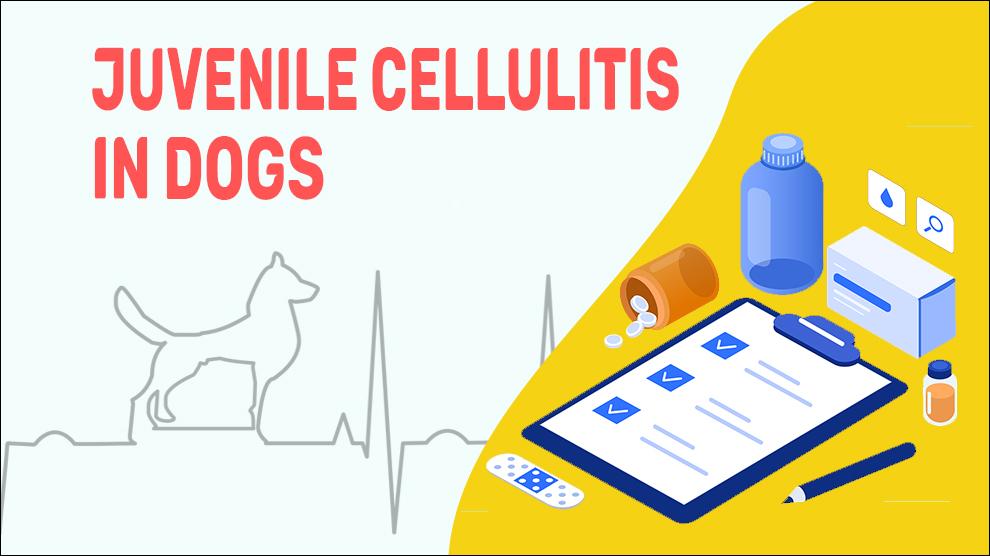Juvenile cellulitis is a rare, vesiculopustular, and granulomatous condition of pups. This most commonly affects young puppies, between 3 weeks to 8 months of age. Sometimes, young adult dogs get affected and in rare cases, it has been reported in dogs up to four years old.
This is also called puppy strangles, lymphadenitis, juvenile granulomatous dermatitis, and juvenile pyoderma. This is preferably called “cellulitis” rather than pyoderma because this condition is sterile. Antibacterial treatment alone cannot cure this condition
As the cause is indefinite and immune system dysfunction is also suspected, some have classified the disease as a “pseudopyoderma”.
This autoimmune disorder may be predisposed in certain breeds. This condition can be painful to puppies but it looks as if they have pimples on their body.
Symptoms Of Juvenile Cellulitis
- Fever
- Malaise
- Enlarged lymph nodes
- Pruritic lesions in the periocular regions, muzzle, face, pinnae
- Lymphadenopathy
- Ulcerations
- Difficulty eating/ swallowing
Treatment Options For Juvenile Cellulitis
- The basis of cellulitis treatment isGlucocorticoids.
- Prednisolone (2mg/kg once daily). This dosage is maintained until the clearing of lesions (2 - 4 weeks). Then, the same dose is given at 0.5 mg/kg daily for three days, on an alternate day basis. Once after a marked reduction in severity and extent of the lesions, the drug can be discontinued.
- Vets use Prednisone along with an antibiotic for the best prognosis.
- Oral dexamethasone: to treat inflammation (2 to 0.5 mg/kg once daily)
- Secondary infections: systemic antibiotics (clavulanate potentiated amoxicillin or Cefadroxil or cephalexin).
- Rarely Cyclosporine (5 mg/kg q12h) is also used
- Oflaxacin, ornidazole, terbinafine, and/or clobestal ointments
Home Remedies For Juvenile Cellulitis
Discuss with your vet before trying any home remedy
- Keep your pet’s facial fold and muzzle clean and dry using hypoallergenic wipes or a clean towel
- Wash out those dirty hair follicles (follicle flushing) using medicated shampoos
- Apple Cider Vinegar (ACV) Green Tea Aloe Vera or nettle can be applied
- A chlorhexidine antimicrobial solution (1:10 dilution) or 5% benzoyl peroxide cleanser can be applied to the area. After 5- 10 minutes, rinse off with plain water. It can be used until the breakout subsides
Prevention Of Juvenile Cellulitis
Juvenile cellulitis seems to have a likely hereditary factor. Certain dog lineages are more likely to develop juvenile cellulitis. Neutering and spaying the susceptible dogs will help prevent the liability for the disease from being passed over.
The best way to prevent this is to maintain proper hygiene with products engineered specifically for dogs and to keep your dog’s skin clean by giving quick wipes after mealtimes.
- Do not allow your puppy to rub their face on toys, carpets, or rugs that have any sharp edges which could scrape the skin and might cause trauma
- Vets also might recommend changing your pet bowls to nonporous, smooth bowls made from ceramic, stainless steel, or porcelain and cleaning them daily.
Affected Breeds Of Juvenile Cellulitis
Golden Retriever, Dachshund, Gordon Setter, Siberian Husky, Young Puppies
Additional Facts For Juvenile Cellulitis
Causes:
- Immune-mediated
- Genetics or predisposition in certain breeds
- Possible overexposure to the sun
- Possible environmental pollutants
The differential diagnosis includes:
- Angioedema
- Adverse cutaneous drug reaction
- Canine distemper
- Chin pyoderma
- Demodicosis
- Dermatophytosis
Diagnosis:
- Cytologic and histopathologic tests
- Skin biopsy
- Blood work, urinalysis
- Biochemistry profile
Morbidity:
- Sometimes, affected dogs are left with permanent scarring that depends on the severity.
- Cellulitic skin is typically painful but not always pruritic
- Almost 50% of affected puppies are depressed and lethargic.
Prognosis:
The prognosis is good with proper diagnosis and prompt treatment. Relapse is rare.
When To See A Vet
Contact the vet immediately, if you notice any of the following
- If the cellulite seems to be getting flared up or if there seems to be an infection or progressively getting worse, you should take your dog to the vet.
- Skin lesions containing pus.
- Burst pustules with bleeding wounds.
Food Suggestions For Juvenile Cellulitis
- Lamb and rice meal
- Sardines, salmon, and cod
- Ground Beef/boiled chicken breast
- Potatoes, Sweet Potatoes
- Steamed vegetables/Frozen veggie blends that contain corn, carrots, peas
Conclusion
In most of the cases, juvenile cellulitis resolves fully with appropriate treatment. Usually, one course of medication is sufficient to treat the condition. Recurrence of the condition is uncommon.
Sometimes, pruritic lesions develop around the eyes; this may result in permanent scarring.

















